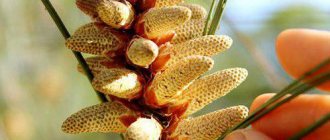Sweet potato is an exotic plant for Russia. Many people still don’t know what kind of vegetable this is. The plant usually grows in Peru and Colombia. After sweet potatoes appeared on store shelves, many summer residents wondered whether this vegetable could be grown in our latitudes. The sweet potato is related to the loach. Lianas usually entwine gazebos on the streets. But sweet potatoes require a lot of attention to get a good harvest. The sweet potato is considered a creeping vine. The length of this vine can exceed 5 meters. Stems usually take root as they grow. That is why the height of sweet potatoes does not exceed 20 cm. Sweet potatoes have many varieties. Not all varieties produce white flowers. And the shape of the leaves can be finger-shaped, heart-shaped. And the fruits are very similar to potatoes. But unlike potatoes, sweet potatoes are large. There are specimens 30 cm long. The peel can be easily separated from the pulp. Methods for growing sweet potatoes in central Russia are described in this article.
Chemical composition
In terms of its chemical composition, sweet potato is simply a storehouse of microelements and vitamins. It contains magnesium, potassium, calcium, phosphorus, iron, folic and pantothenic acids, as well as a large amount of vitamins (A, C, PP, B1, B6).
It is believed that one serving of sweet potato can replenish the daily requirement of vitamin A. Regardless of the fact that sweet potato is considered a sweet vegetable, it has a very low glycemic index and can perfectly complement the diet of people suffering from diabetes.
Advantages and disadvantages of sweet potato
It would take a very long time to list all the advantages of sweet potatoes, but let’s try to dwell on the most important ones:
- Gastrointestinal tract. The product envelops the gastric mucosa and helps significantly improve perilstatics in the body.
- Problems with the cardiovascular system. Due to the content of B vitamins in the vegetable, it improves the functioning of blood vessels, strengthens their walls and helps to cope well with cholesterol plaques.
- Brain and nervous system. Sweet potatoes contain large amounts of potassium, which helps improve connections in nerve endings and helps keep the brain active.
- Excess weight. Sweet potatoes are rich in fiber, which gives the body a feeling of fullness, and a small portion is enough for a person who is losing weight to relieve the feeling of hunger. Moreover, sweet potatoes have very low calorie content and can be eaten without worrying about them being deposited on the sides.
After such a long list of health benefits, it seems that sweet potato does not have any disadvantages and can be eaten by people of all age groups, regardless of health problems. But, unfortunately, everything is not like that at all. Sweet potatoes have some disadvantages that you should be aware of before you start eating them.
Sweet potatoes are strictly contraindicated for consumption by people with stomach ulcers. It is also not recommended for women to eat vegetables during pregnancy and lactation, in order to avoid health problems.
The vegetable contains a small amount of oxalates, which in certain cases can crystallize into kidney stones.
Features of growing seedlings
Although in our country the sweet potato is a guest, this does not mean that the overseas vegetable cannot grow in our latitudes. Sweet potatoes thrive in humid, warm climates. Its growing season takes approximately 180 days, which is too long for the temperate climate of central Russia.
Therefore, our farmers prefer to plant it ahead of time (about 60-120 days in advance), and then transfer it to open soil in the warm season. You can grow seedlings using seeds and roots of the plant. The first option is almost never used in our country, since it is very difficult to get sweet potato seeds, and it takes a very long time to wait until viable seedlings grow from these seeds. Therefore, the option with tubers remains.
Basic cultivation conditions
Sweet potatoes love light soil and moderate watering. He feels especially comfortable when the soil has a high nitrogen content, and it itself is sandy loam with an acidity level of 5.5-6.5. There is no need to be afraid of weeds. As the sweet potato grows, it spreads along the ground and suppresses weeds.
In order to get a bountiful harvest, the temperature should not fall below +25 degrees. As temperatures drop, plant growth slows down. When the thermometer drops to +10 degrees, the plant may die.
Sweet potato - growing in the middle zone
As mentioned earlier, in central Russia the most acceptable way to grow seedlings is the tuber method.
There are three ways to grow sweet potato seedlings from tubers:
- horizontal method;
- vertical method;
- growing in water.
In order to get good seedlings you will need to buy good young sweet potato tubers. You can buy them at the store or from sweet potato growers. The better the vegetables you buy, the more likely it is that they will produce viable and strong seedlings.
The horizontal method means that the root crop is placed on its side in a box with soil and pressed slightly into the ground. Then it is watered generously. It should be noted that holes must be made in the box to allow moisture to escape. The soil itself for germinating seedlings must be pre-treated and well-fed with mineral fertilizers.
It is recommended to place the sweet potato itself in a fungicide solution for a few minutes before planting. It is believed that in this way you can get rid of various plant diseases, as well as speed up its growth.
With the vertical planting method, the tuber is placed in the ground at an angle of 90 degrees to the surface. Depending on what variety you are going to cultivate, you can use a wet or dry germination method.
The box with seedlings must be placed in a dark and warm place. After the sprouts appear, the box should be taken out to a bright place for several hours a day so that the plants gradually get used to sunlight.
Growing in water. In order to germinate sweet potatoes in water, you should select a strong root crop without visible areas of rotting or dents. Otherwise, the sweet potato may spoil due to constant contact with water.
The vegetable is half placed in a glass of water and strengthened on the sides with toothpicks so that one half of it is in the water, and the other sticks out above the water. After a couple of weeks, you will notice that sprouts have begun to spread from the tuber in all directions. All you have to do is carefully separate them from the sweet potato itself and replant it in the prepared soil.
Now that the seedlings have reached the required size for planting in open ground, you need to make sure that the soil is ready to grow a bountiful harvest. The soil must be fed with mineral fertilizers. The sweet potato itself may not be so picky about the composition of the soil, but it still prefers to take root in a place where there is sufficient potassium and sulfur present.
In its homeland, the root crop is considered a perennial plant; due to the warm and humid climate, it does not require special care. But in our latitudes you will have to create more comfortable conditions for sweet potatoes than for other vegetables if you want to get a good harvest.
Plant sweet potatoes in the soil only after the temperature on the thermometer exceeds 20 degrees Celsius. And it is necessary to harvest before the temperature drops below 4 degrees, otherwise the sweet potato will simply freeze.
In addition to soil rich in mineral elements, root crops require abundant watering for rapid growth. The area where sweet potatoes are planted should be irrigated every day, otherwise the root crops will not be saturated with moisture and will not acquire the juiciness for which gourmets value them so much.
You should stop watering the plant about two weeks before harvest. Otherwise, the sweet potato may turn out to be too watery and tasteless from the inside.
Usually, sweet potato seedlings are planted very close to each other, but since the plant belongs to the bindweed family, it is worth leaving a distance of at least fifty centimeters between the beds.
Do not plant other vegetables close to the sweet potato, as the stems of the sweet potato very quickly entangle the neighboring plants and deprive them of the sun's heat and light.
You need to loosen the soil for planting very shallowly, about twenty centimeters. But not deeper, because otherwise the sweet potato will not have time to take root well and bear fruit. Make holes and insert one cutting into each of them so that ¼ of the plant is above the ground. Try not to damage the root system of the plant and plant as quickly and carefully as possible.
In temperate climatic zones, sweet potatoes are most often planted under film, creating greenhouse-type conditions for them. On warm days, the film is removed, and the rest of the time it protects the still fragile plantings from possible worsening weather.
After all the plants have taken their proper places, water the soil generously, but do not create swamps in the beds: sweet potatoes love moisture, but not excessive dampness.
In the case of sweet potatoes, there is no need to worry about weeds; its foliage and stems form a very dense blanket, which deprives other plants of comfortable conditions for further development.
If your heart can be at peace in a situation with weeds, then with pests you should be constantly on alert. Thanks to its sweet root, sweet potatoes are a tasty morsel for mice, moles, beetles, slugs and spider mites. Once the parasites have feasted on this tasty vegetable, they will not leave it alone of their own free will.
You will have to start serious pest control to keep your crop safe and sound. Fortunately, now in specialized stores you can find many effective means to combat crop destroyers. The main thing is to try to treat the plant as thoroughly as possible so as not to give pests a chance.
If there are no problems with parasites, this does not mean that you can relax and do nothing for several months. Even if you have carefully treated all the tubers with a fungicide solution, there is always a risk that the plant will get sick and begin to wither.
This depends on the condition of the soil, for example, if it is too acidic or insufficiently fertilized or moistened. Sweet potatoes can also get sick due to lack of access to fresh air and sunlight (if the plants are suddenly placed in greenhouses).
In order to prevent sweet potato disease and the destruction of the entire crop, inspect the sprouts carefully from time to time. The most common and unpleasant disease of sweet potatoes is blackleg (a fungal plant disease). It is very difficult to get rid of it and it is better to initially take good care of the plant than to allow such an infection to spread.
Sweet potato is a sun-loving plant, and no wonder, because in its homeland the sun shines all year round. Before planting sweet potatoes, carefully inspect your area and choose a place where no shadow falls. It should be fully illuminated and warmed by the sun. It is known that amateur farmers install powerful lamps in greenhouses so that the plants do not lack bright light and warmth either day or night.
It is necessary to feed sweet potatoes several times during the entire growing season. It is better that these are proven mineral fertilizers rich in potassium. If you have the opportunity to fertilize the ground with wood ash, infused for several weeks, the plant will thank you at the end of the season with a bountiful harvest.
Make it a habit to lift all the sweet potato stems off the ground every few weeks and inspect them carefully. Your task is to prevent the stems from sprouting additional shoots that will begin to take root in the ground. In the case when there are more such sprouts, the plant stops spending its energy on the growth and development of root crops, and uses it to increase the roots.
Errors
Formation of additional rhizomes. If you allow roots to grow on lying vines, the main root will become poorer. This will also reduce the harvest.
- Poorly grown seedlings. When growing cuttings, you need to provide as much light and heat as possible.
- Late timing of planting cuttings.
- Lack of insulation at low temperatures.
- Wrong neighborhood - you can’t plant sweet potatoes near corn and soybeans.
- The presence of rodents on the site that can destroy the crop.
Harvesting and storing sweet potatoes
Sweet potatoes, as we said above, should be harvested before the air temperature drops to four degrees. You will notice that the leaves of the plant have begun to turn yellow and have lost their elasticity. This is a signal that the crop is ready to be harvested.
Important! If suddenly you see that all the leaves of your plant are completely dry and yellow, this may mean that the root crops have already frozen and there is no point in saving them.
Before harvesting, remove any trailing sweet potato stems and inspect the soil. It should have characteristic cracks that will tell you where to look for root vegetables.
Take a fork and carefully lift the soil. Do not use a shovel, as the root vegetables are quite fragile and can be broken very easily. Sweet potatoes, unlike potatoes, grow very densely, and there is no point in looking for them in different corners of the hole. Vegetables are dug up in a single bunch. Do not try to pull the sweet potato out of the ground like a potato bush, the root crops will remain in the ground, and even worse, they will break into pieces.
After the entire harvest has been harvested, immediately select suitable root crops in order to use them to produce seedlings for next year. Gardeners recommend washing sweet potatoes with a weak solution of potassium permanganate to clean them.
Place the remaining tubers in wooden boxes, lined with paper or sprinkled with sand. Sweet potatoes do not require special storage conditions. It will thrive at room temperature for several months after harvest.
Choosing the right variety
When selecting a variety, the ripening period, taste and shape of the fruit are taken into account. I would also like to say that sweet potato varieties are divided into fodder, vegetable and dessert varieties. The latter have a sweet taste that is reminiscent of banana or pumpkin. Forage varieties are an excellent substitute for potatoes; their fruits are almost tasteless. Vegetable root vegetables contain less sugar than dessert varieties; they can be used as a potato substitute.
Dessert varieties include Kumara Red and Beauregard. Varieties such as “White”, “Brazilian”, “Japanese” are considered less sweet - they resemble potatoes.
Growing sweet potatoes in the Krasnodar region
Since the Krasnodar region is located in the very south of Russia, the weather there is better suited for growing heat-loving sweet potatoes. There are more warm and sunny days in this region during the season and it is much easier to create favorable conditions for sweet potatoes.
The main thing is not to let pests spoil the root system and protect the leaves from drought. Regular watering will allow you to get a rich harvest in the fall.
Homestead owners recommend planting sprouts in open ground only after the acacia blooms. Then the likelihood that there will be no cold nights and there will be no need to worry much about the harvest is much higher.
Enthusiast farmers began growing sweet potatoes in the Krasnodar region relatively recently. At first, people were confused not only by the appearance of the vegetable, but also by the pronounced sweet taste, incomprehensible to Russian people. In our country, if they say potatoes, they expect to receive a product familiar from childhood, but instead, what appears on the table is food that combines the tastes of various vegetables.
But every year there are more and more connoisseurs of sweet potatoes, farmers exchange different varieties, send seedlings to each other and even try to independently breed new species that will be even better adapted to Russian weather conditions.
Feeding, care, watering
It is better to apply fertilizers for the future bed in the fall. For 1 sq.m. - 3 kg of rotted manure or 5 kg of compost, 15 g of potassium sulfate and 20 g of superphosphate. During the growing season, one or two additional feedings with organic matter are necessary. The plant needs sulfur and potassium, the deficiency of which inhibits growth. Sulfur-potassium fertilizing applied in mid-August works well.
Observing the color of the leaves will help to identify a potassium deficiency in time. In this case, they acquire a yellow, purple or reddish tint.
The crop is resistant to drought, but during the initial rapid vegetative growth and formation of root ovaries it requires abundant watering. Gradually, the frequency and volume of watering should be reduced, and when there are 2 weeks left before the planned harvest, stop completely. Otherwise, the root vegetables will be too watery.
Important! To avoid a decrease in yield, you need to ensure that the vines do not take root in the internodes. To do this, you need to periodically lift them and tear off the young roots.
In case of return frosts, the planted seedlings can be covered with film. Roots suffer from cold more than leaves, so the vigorous appearance of foliage during cold snaps can be misleading.
Weeding is necessary at first, until the leaves of the rows close together. After this, the weeds usually stop growing on their own, suppressed by the large above-ground vegetative mass.
Growing sweet potatoes in Belarus
Belarus is rightfully considered the main potato producer in the CIS countries. The climate here is ideal for growing this beloved root vegetable.
If ordinary potatoes grow so well here, then why not try to grow their sweet brother, the farmers decided and did not put the matter on the back burner.
Since it is necessary to grow ordinary potatoes and sweet potatoes in different conditions, we had to tinker until the overseas vegetable began to produce a good harvest.
Several enthusiastic gardeners boldly took up the task: they obtained seedlings in different ways, groomed and nurtured the sprouts in large boxes on their balconies. They were treated with fertilizers and protected from sunlight.
Of course, in Belarus the question of mass planting of sweet potatoes will never arise and it will never displace potatoes from their pedestal, but many people are ready to diversify their diet with a healthy and unusual vegetable.
If more was said about sweet potatoes and they weren’t considered a vegetable that prefers a particularly warm and humid climate, more people would get involved in sweet potato farming, says one of the first gardeners who planted sweet potatoes in his garden.
General information
Sweet potato tubers actually resemble potatoes in appearance, but are usually larger in size. There is no official varietal classification. However, in China alone, up to 100 varieties of this crop are grown! According to their taste characteristics, they are divided into sweet, moderately sweet and completely devoid of sweetness. By purpose - for vegetable, dessert and fodder. The varieties also differ in the color of the tubers (from white to copper-brown) and their shape (from spherical to elongated, similar to carrots or spindles). Some varieties produce spiral-shaped or large shapeless roots. The skin is easily separated from the pulp.
It grows in the form of a creeping vine up to 5 m long or more, which takes root as it grows and forms new ovaries on the root nodes. In tropical climates the plant is perennial; in more northern regions it requires annual planting.
For growing in mid-latitudes, it is important to choose early ripening varieties with a ripening period of 90-110 days!











